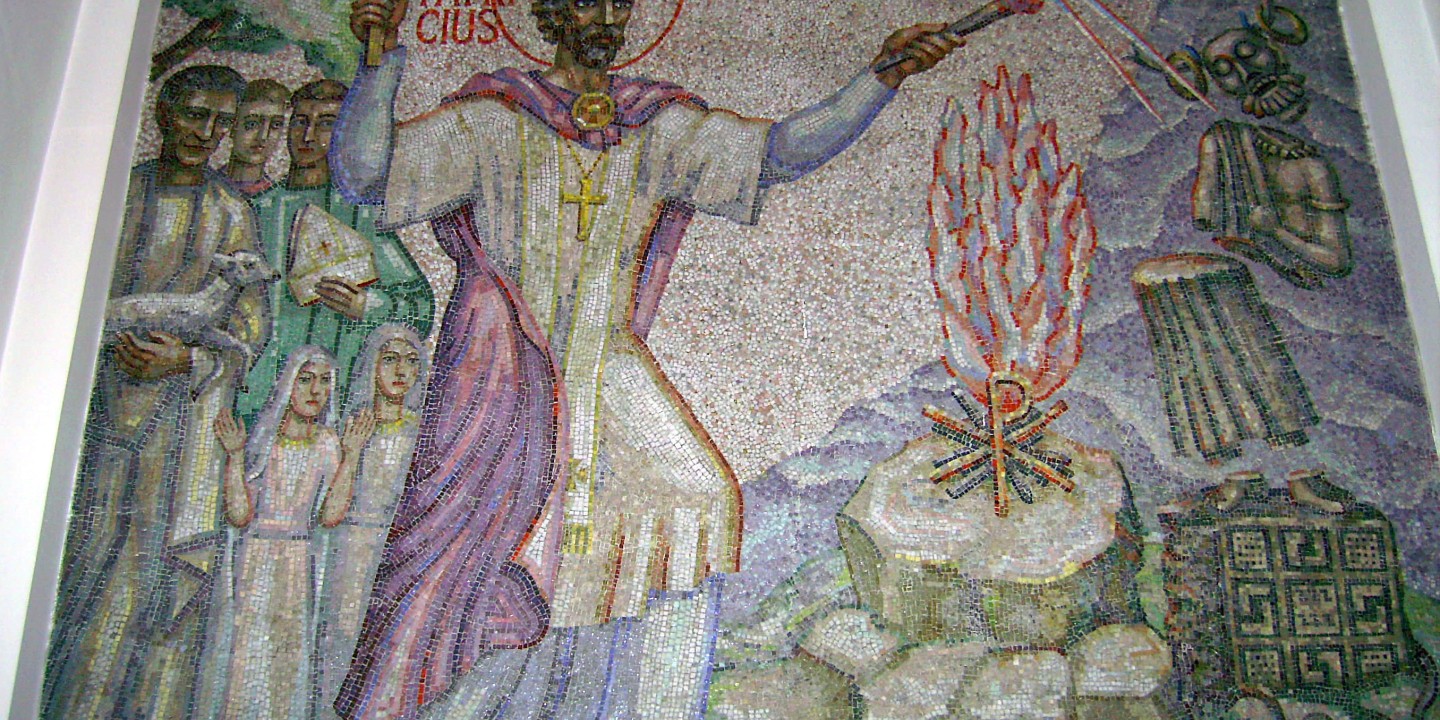How St. Patrick evangelized a violent culture
It is hard to imagine a time or place more opposed to the gospel than fifth-century Ireland.

One morning in AD 401, a young man named Patricius was walking along a beach in western Britain with his family when a fleet of Irish longboats rushed ashore. The warriors crashed onto the beach with braying war horns, terrorizing Patricius and his family as they fled toward town. The warriors demolished the village, discovered Patricius in the ruins, and dragged him aboard a boat bound for the east coast of Ireland. He was sold to an Irish warlord named Miliucc and began living like an animal, spending his days in the wild as a shepherd-slave, terrorized by his master.
In his desperation, Patricius found his nominal Christianity slowly taking on a more substantial form. He began to pray many times a day, and he discovered a rising love and faith in God within his heart. He would stay out in the forests and awaken before daylight to pray in the snow and rain, warmed only by the Spirit of God burning in his heart.
Read our latest issue or browse back issues.
After six years of servitude, Patricius heard a mysterious voice assuring him he would soon return to his homeland. Not long thereafter he heard the same voice say, “Come and see, your ship is waiting for you.” Answering what he deemed to be the call of God, he fled 200 miles across Ireland to a harbor far in the south, where he boarded a ship to Gaul. Upon arrival, he found his way to a monastery, where he studied to become a priest, and ultimately he returned home to Britain. But after many years of faithful service, he heard another voice crying, “We beg you, holy youth . . . come and walk again among us.” Hearing this as a call from God, he rose to answer and served the remainder of his life among the Irish, with whom he had lived as a slave so many years before. Patricius, of course, is better known today as St. Patrick.
It is hard to imagine a time or place that was more opposed to the gospel than fifth-century Ireland. Its economy was built almost entirely on raiding, slavery, and warfare. For several centuries before and after the birth of Christ, the Irish marauded the English coast with relentless zeal. Those who survived their raids were taken captive and sold as slaves. Imagine the horror of serving an Irish war chieftain whose home was protected by a palisade of sharpened tree trunks capped with the heads of slaves who were captured while trying to escape. Indeed, the skulls of victims found many uses, including being sculpted into ceremonial drinking bowls or used as footballs in victory celebrations.
The religious life of Ireland offered no respite from bloodshed. Irish druid paganism was as terrifying as the Irish pirates themselves. Theirs was a bloody religion of human sacrifices, strangled or beheaded to please the druid gods. Several remarkably well-preserved victims have been found in peat bogs. Vessels with them are adorned with images of gods deriving erotic pleasure from eating humans whole.
In short, the realities Patrick confronted in fifth-century Irish life make the challenges facing most others pale in comparison. Even more remarkable is that despite the opposition, Patrick’s efforts were overwhelmingly successful. Within 30 years his small band had converted between 30 and 40 percent of Ireland to Christ. Human sacrifice was eliminated, and slavery and the slave trade were almost entirely abolished.
How did Patrick accomplish such a remarkable transformation in such a short time?
Patrick sought to fulfill his calling to Ireland by building monastic communities. Ian Bradley, a scholar of Celtic Christianity at St. Andrews University, contrasts Celtic monastic life with Egyptian monasticism of the fourth and fifth centuries. Though there are many similarities, a striking difference is that the Egyptian monks generally practiced radical separation from the world, whereas the Celtic monasteries provided places of sanctuary but were also intensely involved in the affairs of the world and the lives of the people they served. George Hunter, who teaches evangelism at Asbury Theological Seminary, makes a similar comparison as he notes that Egyptian monasteries were organized to protest and escape the materialism of Rome and the corruption of the church. The monks built them to cultivate and save their own souls. The Celtic monasteries, in contrast, were organized to save other people’s souls. So Patrick’s monasteries shared with all monasteries the function of being a place of withdrawal, but they were unique in their simultaneous commitment to engagement.
How did Celtic monastic communities accomplish these seemingly paradoxical purposes? Similar to other monasteries, a Celtic monastery was enclosed by a ditch or wall, but the function of the enclosure was entirely different. Rather than blocking out the world, it served more like the lines on a playing field. As one passed through the gate, one entered into a playing field with entirely different rules. Within the Celtic monastic enclosure the rules of the kingdom of God applied. The community was an outpost of the kingdom—a foretaste of heaven. What would one day be true in the new heavens and new earth was anticipated and modeled within the walls of the Celtic monastic community.
Monastic activity included all the multitudinous activities of ordinary life. Celtic monasteries were populated with craftsmen, artists, farmers, families, and children. Cows were herded, sheep were sheared, cloth was made, and crops were cultivated. The earth yielded its fruit for the good of human beings and in cooperation with God’s design. As Philip Sheldrake aptly phrases it, “monastic settlements [were] anticipations of paradise in which the forces of division, violence and evil were excluded. Wild beasts were tamed and nature was regulated. The privileges of Adam and Eve in Eden, received from God but lost in the Fall, were reclaimed.” The enclosures integrated all the elements of human life, as well as all classes of human society.
Patrick’s vision of integrating both sacred and secular also found expression in distinctive forms of prayer associated with the daily tasks of living. There were prayers for planting, meals, journeys, and welcoming guests. The echoes of these prayers and practices are found in the old Gaelic prayers repeated in some of the most remote sections of the British Isles into the 20th century. Consider this prayer for lighting a morning fire:
I will kindle my fire this morning
In presence of the holy angels of heaven,
God, kindle Thou in my heart within
A flame of love to my neighbor,
To my foe, to my friend, to my kindred all,
To the brave, to the knave, to the thrall.
The beauty of this prayer comes in no small part from the intimate proximity of daily tasks of ordinary human life and the spiritual mission to love both God and neighbor.
Emphasizing the role of cultural engagement in the Celtic monastery should not make one doubt the importance of spiritual retreat and contemplation. Life within the monasteries was intentionally structured so there was a rhythm of engagement in and withdrawal from the world. Contemplation was not just for the professional ascetics. Patrick and his followers believed that “all people were called from birth to the experience of contemplation,” so places were constructed within the enclosure for solitude and contemplation.
The most influential leaders of Patrick’s movement often found withdrawal to be essential. Columba alternated periods of intense activity running the monastic community on Iona with months of solitude on the island of Hinba. Cuthbert would withdraw from running the community at Lindisfarne to his hermit cell on the uninhabited Farne Islands. Dyfrig regularly retreated from the busy monastery at Llantwit Major to Caldey Island. These leaders of cultural engagement found their lives unsustainable without seasons of retreat and solitude.
What is most unique about Patrick’s mission was its successful transformation of Irish culture. How did he foster such effective engagement? In short, he did it by faithful action at a local level. He was absolutely committed to the conversion of the entirety of Ireland, but his strategy was always expressed by working in local communities.
Patrick returned to Ireland at age 48, which was about the normal life expectancy at that time. He had no idea how long his ministry would last, but from the first moment he returned to Irish soil he was building a work that would continue long after he was gone. He arrived with 12 companions and a simple plan. He would approach a tribal chieftain to seek his conversion, or at least permission to form a community of faith adjacent to the tribal settlement. The team would then become involved in the life of the community, engaging them in conversation and acts of service such as mediating disputes and tending the sick. Those who were responsive would join the apostolic band and worship with them. If God blessed the efforts, they would build a church. When the group moved on, Patrick would leave a protégé behind to serve the fledgling church while taking one or two young people to join in planting a new church near another tribal settlement. This simple plan was repeated again and again until an Irish civilization arose, like a phoenix, from the ashes of war, slavery, and human sacrifice.
Patrick’s story reminds us that opposition is opportunity. The harsher the oppression, the deeper the wounds and the more desperate the need for the gospel. Patrick landed in an Ireland awash with blood. A peace-filled monastic community was a colony of heaven in a continent of hell. Creating enclaves of human flourishing and divine peace and reconciliation made the most compelling of arguments in favor of the gospel he preached.
One of the observations commonly made by Patrick’s biographers is the depth of love he felt for the Irish people and their culture. For all of Irish culture’s appalling problems, Patrick was keenly aware of its beauty. He found himself in the midst of loyal, courageous, and generous people—qualities that he could not help extolling when he described the Irish to others. He found people who were deeply in awe of the beauty of nature, and whose posture toward creation served as a ready foundation for Christian worship. Having been a slave himself, he deeply empathized with the plight of the slaves who surrounded him—all too many of whom were Irishmen enslaved by their brethren. Patrick could admire and praise the image of God in all he encountered, no matter how badly it was tarnished.
A version of this article appears in the June 7 print edition under the title “The gospel in a violent culture.” It was excerpted from Winsome Persuasion, © 2017 by Timothy M. Muehlhoff and Richard Langer. Used by permission of InterVarsity Press.






